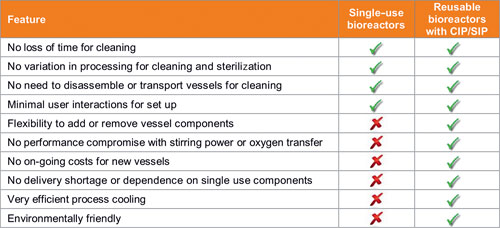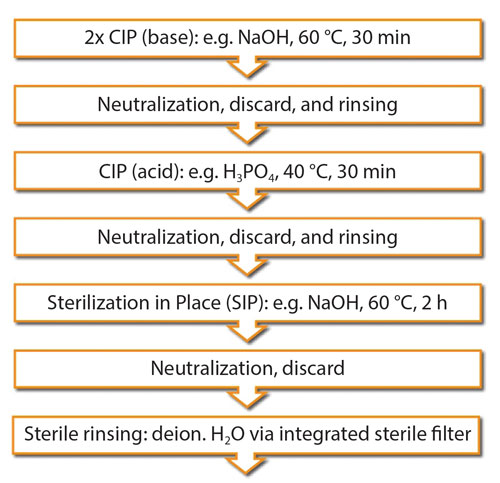September 15, 2014 (Vol. 34, No. 16)
Dirk Hebel, Ph.D. product manager Infors
Infors HT Develops an Approach Designed to Increase System Throughput
Quick and efficient bioprocess development is vital for researchers in industry as well as for those at universities or research institutes. Hence, low-maintenance bioreactors that are easy to operate and always ready to use are an emerging requirement for many users.
A major factor that limits the throughput of bioreactors is the time spent for cleaning and sterilizing the vessels. While clean-in-place (CIP) and sterilize-in-place (SIP) are standard features of larger-scale steel bioreactors, this functionality used to be unavailable for the more compact lab-scale bioreactors. Some consider single-use vessels as a solution, but they have some drawbacks in comparison to reusable steel and glass bioreactors (Table).
In large, stainless-steel bioreactors, CIP is usually performed by pumping a hot cleaning solution through the bioreactor and all the pipes in contact with the media. The solution, commonly NaOH, dissolves any dirt from within the bioreactor so it can be flushed out of the system.
Additionally, the solution is pumped through spray balls that are inserted into the bioreactors. This helps clean the vessel and the top plate by means of mechanical energy.
For small-scale glass bioreactors, there usually is not enough space for the insertion of spray balls into the system. Also, most of the systems don’t feature a bottom valve that can be used for emptying the vessel after CIP.
Engineers at Infors HT have come up with a similar, yet different approach—the LabCIP process.
Using hot NaOH solution for CIP was a given—the chemical is available in every lab, and the bioreactor can easily heat the solution to 60°C. For a more convenient operation, a concentrated solution (e.g., 8 M NaOH) is provided for the LabCIP process and automatically diluted to the correct concentration within the bioreactor.
After giving up on the idea of tiny spray balls, the engineers chose to make use of existing equipment: The motor of the Labfors 5 generates a lot of torque, up to 1.2 Nm with the strongest option. By installing an additional Rushton impeller in the head space, this force can be used to clean the vessel and the top plate.
The next challenge was to get the liquid out of the bioreactor. The easy approach would have been to change the glass vessel to one with a bottom valve. This, however, would have increased the height of the bioreactor and consequently made handling of the bioreactor more difficult.
Experiments revealed that a slight overpressure is sufficient to push out the liquid through the dip tube of the bioreactor. The tube was altered to become a harvest pipe leading all the way to the bottom of the vessel.
After the engineers connected a line for deionized water to the LabCIP unit and a level sensor to the bioreactor, all the features for performing CIP were already available with a modest amount of extra equipment.

Table. Comparison between single-use and CIP/SIP reusable vessels for high-throughput fermentation
Sterilization-in-Place (SIP)
Sterilization using pressurized steam cannot be performed with glass vessels due to safety considerations. The only option available until now was to place the vessel inside an autoclave, where it can safely undergo the steam sterilization. This, however, requires a lot of manual work and some heavy lifting.
Many different options were evaluated, and most of them were discarded rather quickly. Dry heat requires even higher temperatures, which the plastic components around the bioreactors cannot withstand. Disinfectants were not an option either, as they can be environmentally unfriendly. Also, any residues could adversely influence the subsequent bioprocess.
Finally, a concept for chemical sterilization using NaOH was developed. Even at 25°C, NaOH solutions have a sterilizing effect on microorganisms with D-values ranging from approximately 4 to 20 minutes. The resistance of the microorganisms to the NaOH solution decreases with increased temperatures.
A group led by Alvar Gossert, Ph.D., at Switzerland-based Novartis carried out experiments showing that treatment with 0.1 M NaOH at 60°C efficiently sterilizes bioreactors contaminated with Escherichia coli, Pichia pastoris, or Geobacillus stearothermophilus. Subsequent sterile tests showed that the bioreactors remained sterile for at least 6 days.
To automatically sterilize the bioreactor, some modifications were necessary. The vessel needs to be completely filled during sterilzation, which must encompass the lines for sampling; the sparger; the exit gas cooler; and the inlets for acid, base, antifoam, and feed.
Therefore, an additional level sensor was installed as part of the LabCIP unit outside the bioreactor to determine when the vessel and its peripherals are completely filled. Special valves were developed to separate pre-sterilized air filters and process lines from the bioreactor during sterilization.

Figure 1. For LabCIP to work, Infors HT has developed a special set of valves that are presterilized with the air filters. The valves allow for the filters and the air connections to stay sterile even when connected to a bioreactor before CIP and SIP. After the air filters and process lines are replaced with a set of presterilized ones, the CIP and SIP process is started by pushing a button. At the end of the LabCIP process, the valves are automatically opened by air pressure provided by the Labfors 5 (sparger) or the LabCIP unit (exit gas cooler).
After the process, the valves open and connect the presterilized peripherals to the sterilized bioreactor.
The valves on the sparger and on the exit gas cooler have separate outlets to enable circulation of the hot NaOH solution (Figure 1). Hence, every part of the bioreactor in contact with the bioprocess is in contact with the hot NaOH solution and gets properly sterilized.
The complete setup combines features of the Labfors 5 with specialized functions in the LabCIP unit, with everything controlled by intelligent software running on the Labfors 5 touchscreen controller. The footprint of the additional LabCIP tower is the same as a sheet of A4 paper. Consequently, the system can be set up even in tight spaces, e.g., under a fume hood.
As for large-scale bioreactors, the CIP and SIP processes are customizable by the user. By default, the bioreactor is cleaned with hot NaOH solution and consequently sterilized with hot NaOH solution for two hours.
If, however, additional CIP steps with acid are required or the microorganisms from the previous bioprocess can be eliminated more easily, the user can adjust these parameters by pushing a button (Figure 2).

Figure 2. The LabCIP process can be individually configured according to the requirements of the user and the bioprocess. In this example, CIP is performed twice with base and once with acid to remove tough biofouling and precipitates.
Dirk Hebel, Ph.D. ([email protected]), is product manager, bioreactors at Infors HT.







